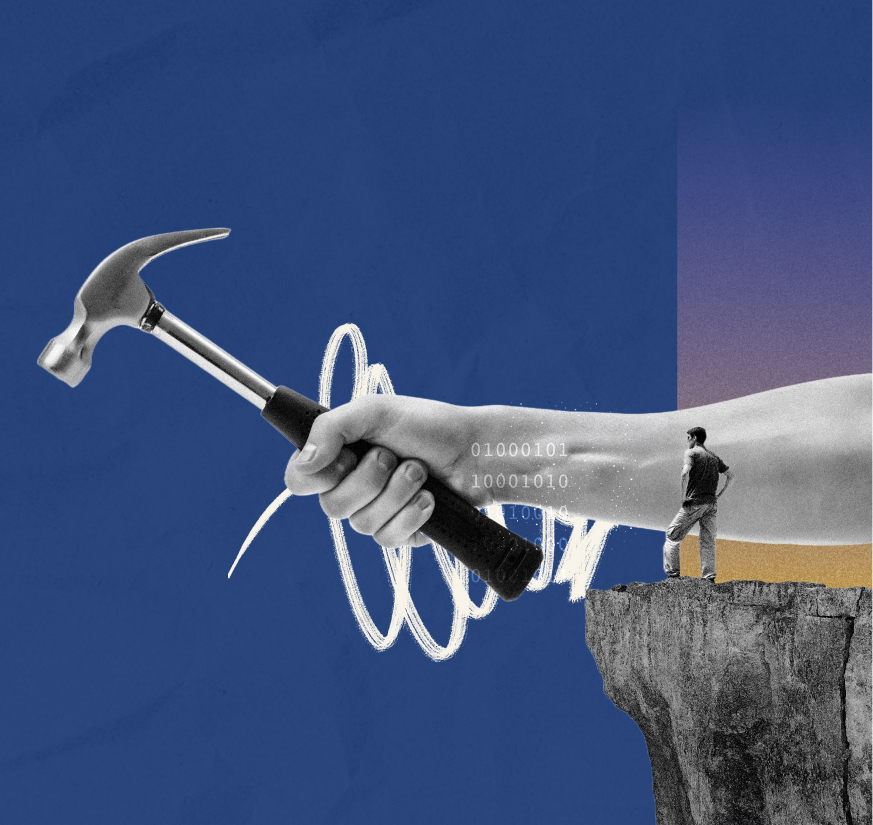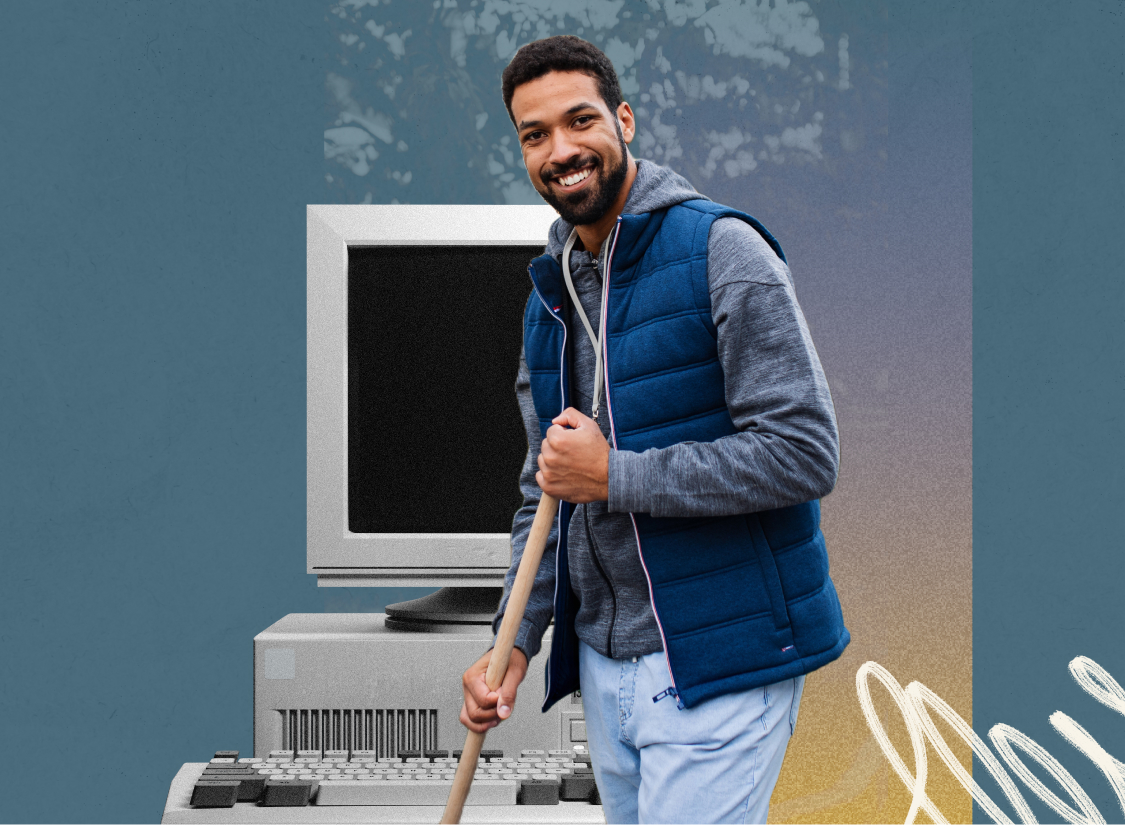The 7 Trends That Will Shape Your Future CSR Plan

David Hessekiel, founder of Engage for Good, has spent the bulk of his career advocating for corporate social responsibility. But as he remembers it, 40 years ago, when he started business school, “Nobody was talking about CSR…it was still a time when people might quote Milton Friedman and say ‘the business of business is business.’”

David Hessekiel, founder of Engage for Good
Today, social impact is increasingly a core tenet of modern business. That’s thanks to the CSR professionals willing to challenge yesterday’s best practices. They are the ones who ensure that the field continues to evolve, shedding the assumptions, processes, and dynamics that no longer serve the work. And it’s their vision that continues to reshape the entire corporate sector.
To learn what’s in store for CSR in the year ahead, we talked to dozens of the most dynamic leaders and practitioners in the space. They share their perspectives on where corporate social responsibility is headed next. And they all seem to agree:
The future of CSR hinges on its ability to stay rooted in the humanity that’s at the core of the work. It has to map to reality—with all its complexities, contradictions, and nuance.
With that in mind, here are the seven trends shaping the future of CSR, according to the experts.
Step into communities with humility
Whether you’re running a community investment program or an employee volunteering initiative, make an effort not to run roughshod over the community you seek to support. Moving with humility is essential.
John Brothers, president of the T. Rowe Price Foundation, has helped to pioneer a trust-based ethos in the corporate sphere. He explains what humility looks like: “For us, trust-based means when we have the good fortune of being able to step into a local community, we are walking into somebody's home, and we hold that ground sacred.”
This framing is important. Rather than seeing your financial support as something communities should be grateful to receive, understand that being invited into a community is a privilege, and act accordingly.
Listen and learn from nonprofits
When you seek out nonprofits whose focus aligns with your CSR mission, remember that they have likely been engaged in the work for a while. They have experience and can offer unique insights, if you’re willing to listen.

Devi Thomas, global head of nonprofit community capacity at Microsoft Philanthropies
Devi Thomas, global head of nonprofit community capacity at Microsoft Philanthropies, sees nonprofits as a source of knowledge. A big part of her work is understanding their perspective. “What's most interesting to us has been to listen and learn what's actually working in those communities to drive change,” she says.
As you build relationships with community organizations, remember that the last thing they need is a corporate funder trying to explain their daily realities back to them. As John Brothers says, “No one is sitting in any community saying ‘I can't wait for John Brothers to tell me what impact is.’”
Prioritize relationships over proof of impact
Relationships are at the heart of trust-based philanthropy—prioritize them as such. Too often, funders see themselves as watchdogs, monitoring the nonprofits they support for proof of impact. This dynamic corrupts relationships. As John Brothers says, “If I walked into your home, and said, ‘step on the scale and you should weigh what I think you should weigh,’ you’d tell me to get the heck out of your house, as you should.”
Yes, impact measurement is an important component of CSR. But that should never come at the cost of the relationships that make social impact work possible.
Critics of trust-based philanthropy often decry the lack of accountability, but this shows a fundamental misunderstanding of what trust-based philanthropy actually is. Accountability is built in. But it doesn’t look like what some funders are used to—being watchdogs over their grantees while grantees try to prove their effectiveness. Instead, accountability moves both ways. Like a true partnership, grantees and funders are accountable to one another to each do their part to make an impact for the community.
To fold trust-based practices into your CSR efforts, start by focusing on the people doing the work—and their stories. That in itself will help define the partnership as one of mutual respect and understanding. John Brothers recounts when he first sat down with a community leader in Baltimore, she used data to try to prove her worth:
“Before I could even really know her name, she pulled out all these charts and graphs to show me why she was valuable,” Brothers says. “I didn't get a chance to see what she felt was important and what was the north star for her organization.”
Making room for people to share their personal stories doesn’t mean the conversation never shifts to the hard data, it just allows everyone to bring their full selves to the work first.
Like almost any other relationship, you need to start with empathy, and build from there. Once you see each other fully as people, you can work together much more effectively toward a shared vision of progress.

CSR says, “yes, and…”
In the past, CSR has meant a lot of “either-or” questions: focus programming on environmental causes or social justice? Create initiatives around employee engagement or community investment? Now, CSR professionals are taking an expansive view of what’s possible. Instead of asking “either, or?”, they’re saying “yes, and…”
This shift to more expansive thinking is thanks to a deeper understanding of the way issues intersect and overlap. CSR professionals and corporate leaders recognize that no social issue exists on an island. Environmental sustainability is inextricably linked to social justice. To make lasting progress on either issue, you must build your strategy around that interconnectedness.
Shifting from a narrow approach to a more expansive strategy is not just about reframing your thinking. It’s about proactively aligning your programs to honor this world view. To do so, you must apply an intersectional lens to your CSR work, take a multi-faceted approach to problem solving, and balance short- and long-term outcomes.
Apply an intersectional lens
Applying an intersectional lens to your work will allow you to see how communities experience layers of injustice, and how those injustices compound each other. It’s the first step to building a CSR strategy that incorporates interconnectedness.
First coined by Columbia law professor Kimberlé Crenshaw, intersectionality has evolved from a legal term to a broader social theory. It’s born from a belief that people’s experiences are shaped by their unique identities. It means that to effectively address any social issue, you have to understand how that issue overlaps and intersects with other issues, and how those layers shape individual experiences.
Jamie Gloshay, co-founder and co-director of Native Women Lead, builds programs to support Indigenous artists. She explains how someone’s identity can affect their experiences within traditional banking:
“Within the financial system, there's a lot of distrust and harm that has been caused by economic exclusion of Indigenous and Black and brown folks. And that exclusion gets institutionalized in the very frameworks and underwriting process that finance utilizes to determine who's worthy of risk.”
As she develops strategy, Gloshay does so in ways that acknowledge this history of exclusion and distrust. Without that understanding, the organization might end up building programs that exacerbate that marginalization and alienate the very people they’re trying to support.
Applying an intersectional lens takes work. Start by listening and learning from community members. As Jaimie Vargas, head of global social impact at Electronic Arts says: “The work really is strengthened when more voices are around the table.” Make an effort to understand the historical context of issues you seek to solve, consider the systemic forces at play, and aim to build solutions that change systems and institutions.
Take a multi-faceted approach to problem solving
Taking a multi-faceted approach to social impact allows you to use all of your organization’s strengths and resources for good. Rather than looking for one or two ways to make a difference, explore all the avenues you can take to make an impact. This could look like:
employee volunteering and giving
cross-sector partnerships
product donations
supply chain management
sustainability initiatives
advocacy work
Essentially, you want to look for all the ways in which your organization is positioned well to help the community. You don’t have to have all the answers here. Community partners can play an important role helping you to define what they need beyond funding.
Microsoft Philanthropies uses their connections to help link efforts across sectors. “We believe that no one company, industry, or country can solve some of the most complex problems alone,” Devi Thomas says. “So, we like to build that bridge across sectors and borders, foster that collective action to drive progress so much faster than we can do on our own.”
From John Brothers’ perspective, companies often overlook how much they have to offer. “We know places like Baltimore—where we do a lot of our work in a very place-based way—struggle with infrastructure. And that's what often companies have in abundance,” he says.
To take a multi-faceted approach, consider all your company’s departments, internal processes, and resources and how you might mobilize each for the community. Seek input from your partners about what would be most useful to them.
Balance short and long-term outcomes
CSR programs should meet immediate, short-term needs of communities while also creating long-term change. Influenced by profit-focused corporate frameworks, CSR professionals have become accustomed to prioritizing short-term outcomes of social impact work. Incorporating a longer change horizon makes programs more effective.
When John Brothers advocated for a trust-based ethos within his organization, he made a case for incorporating a long-term view. Rather than just funding programs, he wanted funding to strengthen the nonprofits themselves.
To explain it to his corporate team, he put it in business terms. He asked whether they would invest in a product or a company—essentially would they invest in Diet Coke or in Coca Cola. Their response was: “We would never invest in only a product of a company. We would invest in the company and we would hope they would have great products.” Using this framework helped him make the case for taking a longer change horizon in their social impact work.

Jaimie Vargas, head of global social impact at Electronic Arts
Part of striking a balance between short and long-term change is understanding the full value of CSR programs. Yes, they can deliver aid and make an immediate impact. But they can also shift the culture within your organization. As Jaimie Vargas says, “[CSR] is not a cost center. It's a pride center and it sits at the heart of criss-crossing functions, and has a lot of dependencies across a company.” It’s important to account for this value, even if it’s hard to quantify.
To balance short- and long-term outcomes, consider how you can meet urgent needs of community members while also strengthening the infrastructure that will support more systemic change, both internally and externally.

Program resilience is a priority
CSR programs are only strong as long as they have staying power. That reality was particularly potent in 2022 and 2023, when market fluctuations rippled across sectors and put CSR on the chopping block at some companies.
CSR professionals have a renewed interest in building resilient programs that can withstand market fluctuations, leadership changes, and other outside forces. This resilience ensures stability within their team and is better for the community. When nonprofits can rely on sustained support, they can do more innovative, strategic work. If corporate support is fickle, nonprofits are constantly guarding against the possibility that funding will evaporate, hamstringing their ability to think long-term.
To create programs with staying power, hook your CSR initiatives to broader business strategy, get employee buy-in, and prioritize authenticity.
Hook CSR to broader business strategy
Anchoring CSR programs to your broader business strategy ensures that your social impact work aligns with the overarching vision your company has for the world. That alignment intertwines business success and CSR success so that each bolsters the other.
Fred Tan, head of global social impact at Hewlett Packard Enterprise, has made it his goal to tie CSR to business strategy. One of the projects that best encapsulates this effort is the cogeneration plant HPE built in Puerto Rico. The plant provides continuous power, fueled by locally-sourced 100% renewable natural gas to support HPE’s manufacturing. It also serves as an emergency shelter for a community that is prone to hurricanes.
“Because it is independent from the Puerto Rico energy grid, it is able to continue operating, even in the event of a disaster,” Tan says. “And that enables team members, families, communities, to now have a place to shelter from the elements with power.” The success of the plant is inextricably tied to both HPE’s business and their social impact mission.
Luckily, corporate leaders are starting to understand the very real benefits of CSR for a business. In a study by KPMG, 74% of C-suite executives said that they see ESG supporting their bottom line. Since CSR programs are an essential component of ESG efforts, that bottom line impact is only possible if you have alignment between your CSR and business missions.
To hook CSR programs to broader business strategy, start by identifying your company’s values. Use these values to map out the ideal world your company wants to help create, and tie all your social impact efforts to that vision.
Get employee buy-in
In some ways CSR programs are like any other corporate initiative—they only work if employees are invested in their success. Without employee support, CSR initiatives don’t have the lifeblood they need to survive.
As Jaimie Vargas of Electronic Arts sees it, employees should have a hand in shaping CSR programs from the beginning. “Everybody's on the social impact team,” she says. “Social impact is a part of all of our jobs—despite where we sit, on our day to day functionality. In reality, CSR strategy is really co-created.” She advocates for a model that puts CSR leaders in collaboration with employees.
Employee resource groups (ERGs) are fertile ground for the kind of collaboration and feedback that you need to incorporate employees’ perspectives into your CSR plans. For Vargas, ERGs are essential stakeholders that guide the company’s social impact work. As she designs programming, she aims to align it with employee values and give every employee a way to get involved.
To ensure you have employee buy-in, incorporate employee voices early and often. Establish forums and feedback loops that you can tap into for input. And check in with employees to be sure that your program stays true to their vision as it grows and evolves.
Be authentic, not reactive
To show up authentically, companies need to be proactive about building CSR programs. If employees and customers sense that social impact initiatives happen reactively, they’ll start to see the efforts as disingenuous. Rather than waiting for outside pressure to force the issue, companies should be proactive about building relationships in the community.
John Brothers has seen many companies learn this lesson the hard way. After George Floyd’s murder, 20 companies in Minneapolis reached out to the T. Rowe Price Foundation team to get advice on how to build authentic relationships in the community.
Brothers advocated for some self-reflection: “What we said is those folks who are [protesting] on 38th and Chicago are not only upset that they lost George, who was their friend, their brother, their neighbor. They’re also upset about the conditions that were created that allowed that to happen—for which you were a part of.” Often, authenticity requires companies to face some hard truths about how they’ve shown up (or haven’t) in the past. That work is essential to plotting a course toward change and building authentic relationships within the community.
Part of the reality of CSR work is that you have to prioritize some causes over others. To show up authentically, Jaimie Vargas encourages CSR professionals to tap into employee values.
“There's a lot to learn from employee resource groups, and healthy pressure points too,” Vargas says. “Companies can't show up in every single way that employees demand. It's just not possible to show up for all the issues that are out there. And it may not be the right way frankly for a company, to show up in every issue. But it is important to listen and learn.”
To weave authenticity into your CSR program, don’t wait to ask the hard questions. Take time to interrogate your company’s history in the community, and invest in relationships before you need them. That way, when the community needs you most, you won’t be caught back on your heels.

Corporate philanthropy prioritizes community strengths
Communities don't identify with their needs, they identify with their strengths. As a CSR professional seeking to help communities, you need to recognize this in your work. Without that recognition, social impact programs run the risk of disenfranchising the very people they seek to uplift.
When funders view communities only in the context of what they lack, they aren’t able to honor the richness that already exists within a community—the relationships, the informal networks, and the values.
CSR teams should make an effort to get to know community members beyond what they need, so they can build programs that reflect how the community sees itself. John Brothers explains why this broader lens is so important: “Communities don't recognize themselves as needs. They recognize themselves much differently. The only way needs come in is by outsiders coming in and constantly talking to them about what's wrong with them,” he says.
To prioritize community strengths alongside their needs, CSR teams need to let go of the savior mentality, consult with community members, and retool their funding applications to align with this deeper understanding.
Let go of the savior mentality
The first step in prioritizing community strengths is letting go of the notion that you’re stepping into the community to save people. Communities don’t need to be saved. That’s not your role. You’re in a position to provide resources and support, but first you need to understand how communities see themselves.
Devi Thomas encourages CSR teams to consider how they show up to collaborate. “A lot of times, there is a sense when a corporation is sitting at a table with a nonprofit, that corporation might have the answer to everything,” she says. “But the reality is, the more proximate you are to the problems, the better view you have of exactly what's needed to help local communities. And those solutions are coming from the local communities themselves.”
It’s important to remember that community members deeply understand the nuances and daily realities that shape peoples’ experiences. And they likely have a sense of what kind of programs will and won’t succeed. Your CSR program should invite them to show up as full people—with all their opinions, ideas, strengths, needs, and complexities.
Consult with the community
Before you build your program strategy, consult with community members. Their input will help you shape programs that provide the right kind of support.
Making time to connect with the community requires patience. But that patience has a big payoff. It gives you the chance to get things right.
John Brothers has seen what happens when companies skip this step. In fact, he often takes his community partners to a playground in West Baltimore to help them understand the stakes. Eight years ago, 15 companies came together to build the playground. But it’s not what the community needed. “That playground has sat there unused for eight years,” Brothers says. “No community members ever asked for that.”
As you seek feedback from the community, be sure that you’re not just giving them room to define solutions, but you’re also providing latitude for them to define the problems and opportunities.
Retool your funding application
Your funding application is often a starting point for how you collaborate with and support grantees. The way you frame the application can have a profound impact on your relationship with community members.
Rather than framing the application questions solely around what communities lack, make space for people to share what they’re excited about and what they see as community strengths. As John Brothers says, “I don't know any service in the world that you can build off of a glass half empty.”
It’s also important to give applicants the opportunity to tell their full story as they wish, including personal and historical context of their experiences. Communities United, a survivor-led, intergenerational racial justice organization in Chicago, focuses on healing and repair.
“When we describe survivor-led, it means really looking at the narratives of harm that has come to you, but that in itself is not the end of the road.”
Take a look at your funding application from the applicant perspective. Imagine if you were tasked with filling it out. Ask yourself whether the process and questions would leave you feeling empowered or diminished.
Consider retooling your application to prioritize community strengths and give space for people to tell their full stories. Ask open-ended questions and give people the opportunity to tell their stories in the format that feels most comfortable for them—whether that’s in writing, audio, video, or something else.
Let go of your expected outcomes
To be innovative, you need to move away from the notion that you will be able to accurately predict the outcome of your social impact programs. By nature, innovation requires you to try something you haven’t tried before. And that means you won’t know exactly how everything will play out.
In Fred Tan’s experience, CSR professionals need to get out of their own way a bit. “Sometimes in CSR, we like to be sure of what we're getting out of our philanthropy,” he says. “We want to know what the impact will be and we want to very quickly be able to quantify that impact.” The problem is: the desire for predictability can derail innovation.
Instead of viewing CSR programs as machines that produce specific outcomes, see them as a space to experiment with new approaches. Prioritize answering questions over getting predictable results. And continue to evolve your programs based on what you learn.
Get comfortable with risk
By nature, innovation is a bit risky. It’s possible that you’ll put resources toward a new initiative and it won’t have the impact that you hoped. It’s important to get comfortable with that possibility.
Corporations are in a unique position to innovate in the social impact space. They can take risks that nonprofits and public sector agencies often can’t.
Microsoft Philanthropies’ Devi Thomas explains: “We can take on some of the risks associated with making mistakes. And that is not something that someone who serves communities in life improving or life changing ways is necessarily going to be able to do.” Shouldering the risk of innovation allows companies to develop new solutions and provide the proof points that nonprofits and government agencies need.
Jen Carter, global head of technology and volunteering at Google.org, explains the company’s CSR approach: “We tend to think of a lot of our work as risk capital…we can make these catalytic investments, we can test out new ideas, and we can build proofs of concept that then others can invest in more heavily.”
Risk is the price of innovation. To get comfortable with it, map out the potential value of taking risks—not just for your programs, but for the whole philanthropic sector. And be sure to weigh the risk of testing out new ideas against the risk of not innovating at all.
Support the ecosystems that create true innovation
True innovation doesn’t happen out of nowhere—it requires the right systems and processes in place to identify worthwhile ideas and develop them into sound strategies. Sometimes the best way to support innovation is to invest in the ecosystems that underpin it.
At Lever for Change, a part of investing in the ecosystem to support innovation was a shift away from a traditional grantmaking approach to a challenge model. Kristen Molyneaux and her team realized that some common grantmaking processes were barriers to innovation.
So, Lever for Change asked themselves: “What would happen if we gave organizations the runway not only to do the work but to not have to focus on fundraising every step of the way—to provide them an opportunity to think big?” The challenge model allows community organizations to define the problems and solutions they want to work on, and Lever for Change gives big-dollar awards to support long-term innovation.
At Hewlett Packard Enterprise, part of the efforts to support innovation in the climate space include improving diversity in the startup ecosystem. With only 2% of venture capital going to women founders, the HPE team realized that a lack of diversity was holding back innovation.
As Fred Tan puts it: “The ecosystem in general overlooks large communities of innovators. And that's a huge problem because when we overlook huge communities of innovators, what essentially happens is that there are lots of solutions that never get a fighting chance to see the light of day.” Today, HPE is focused on supporting a diverse group of innovators to help address climate change.
Creating innovation often requires you to step back and examine the systems and people that make innovation possible. Then you can shape your efforts to strengthen the relationships, improve processes, and build up the ecosystems that sustain it.

Data finds its human context
Social impact practitioners are beginning to unlock the power of data more than ever before. But the future of CSR isn’t just about hard metrics, it’s about understanding the data within the context of human realities. Without that human component, the data isn’t all that useful.
Over the past few years, new capabilities have reshaped expectations around what data can and should be able to do for CSR. And while those expectations continue to rise, today there’s a deeper understanding of the potential and limitations of data as it’s understood in the context of real people’s experiences.
No matter where you are in your data journey, build a human context around the data you collect. To do so, prioritize quantitative data and narrative storytelling, check in with community members, and connect quarterly objectives to long-term goals.
Prioritize narrative storytelling alongside quantitative data
Narrative storytelling gives you a deeper, more nuanced understanding of how accurately quantitative data captures the real-world experience of community members.

Jamie Gloshay, co-founder and co-director of Native Women Lead
Making space for narrative storytelling often requires new frameworks. When Native Women Lead (NWL) and New Mexico Community Capital teamed up to apply for the Equality Can’t Wait Challenge, they wanted to provide financial support to Indigenous women. But NWL co-director Jamie Gloshay knew that financial security was not the only measure of success. “Money is not the only thing that people value. People value access to culture and language and their homelands and clean water, clean drinking system, safety is a big deal for Indigenous women,” she says. As they developed the proposal, they sought to include these values in their plan.
Narrative storytelling allows you to better capture the community’s experiences and gives you the chance to communicate your CSR values more effectively with external stakeholders, such as your customers. MiiR puts a code on every one of their products so that customers can register their products and view how their purchase supports the company’s social impact efforts.
To enact narrative storytelling, build frameworks and use technology that allows you to capture and communicate personal stories alongside hard metrics.
Check with community members
The only people who truly know whether data captures a community’s experience are the community members themselves. Make it a priority to check in with people before you launch a program to learn what data they would find valuable. And then check in with them again once you have data collected to understand whether the data captures their experiences.
John Brothers believes that communities know best what to measure to gauge the success of social programs. They should be the ones helping to shape your data strategy. He has been in situations in which community organizations ask him what they should measure. But he resists doing so. Rather than dictating priorities to them, he sits down with them to work together to figure out what’s important and how to capture it.
As you seek to interpret your data, find ways to invite community members into the process. They have the ability to add important context and nuance. For instance, a data walk brings together researchers, community stakeholders, residents, and program administrators to explore findings about a community.
Checking in with community members will save you from misinterpreting or making inaccurate assumptions about your data. To build this into your program, establish relationships with community partners and make the time and effort to share data with them.
Connect quarterly objectives to long-term goals
Since many companies are accustomed to thinking about their business performance on a quarterly basis, CSR programs provide a unique opportunity for leaders to explore what it means to operate with a longer change horizon.
Kari Niedfeldt-Thomas, managing director of corporate insights & engagement for Chief Executives for Corporate Purpose (CECP) says that a big part of her role is helping corporate leaders take a longer view—not just in terms of social impact, but for the health of the business itself.
“We know that it's very easy for companies to get caught up in the quarterly analyst conversations that are happening. And those quarterly returns calls can often have companies find that they're not centered truly on their long-term strategy.”
Framing your data strategy around long-term goals will help solidify your CSR efforts within your company. You’ll be able to better communicate expectations and bottom-line outcomes to leadership.

CSR becomes digitally native
CSR programs are no longer being retroactively mapped onto tech solutions. Instead, social impact efforts are being developed and designed with technology at their core.
For today’s CSR teams, incorporating technology like CSR software is an essential part of creating and sustaining successful programs. To do so, make tech a part of your plan as early as possible, incorporate AI where it makes sense, and choose technology that’s easy for everyone to use.
Make tech part of your plan from the beginning
Rather than building your CSR program and then finding spots where CSR-focused technology can slot in, aim to design your programs with technology right from the beginning. This saves you from building processes that you’ll have to retrofit to use technology later on.
Many CSR leaders are finding out that CSR-specific technology is not just a tool—it’s a foundational component to their work. The right software can transform an entire program and shape people’s relationship to it.
Trulieve, a medical cannabis company, experienced this first-hand. They shifted from a combination of emails and spreadsheets to CSR software, which allowed them to centralize their corporate volunteering efforts. That change helped to redefine the program. With a personal dashboard, employees felt more empowered to get involved. In turn, participation went up 55%, and program managers had more time to spend with community partners.
Don’t wait to apply a technology lens to your social impact work. Build CSR technology into your plans from the beginning by mapping out your priorities before you build processes, exploring software options early, and learning about how other teams do their work.
Incorporate AI where it makes sense
Artificial intelligence is no longer a distant promise—it’s here, and it has the power to reshape social impact work at every level. From automations that simplify program management to predictive modeling that can determine where and how to distribute aid should, the possibilities of AI are expanding faster than ever.
Devi Thomas, global leader of nonprofit community capacity at Microsoft Philanthropies, has seen AI make a big impact in the philanthropic sectors. She’s seen large language models help nonprofits automate tasks and free staff up for more relationship building.
When wildfires spread in Maui, the Microsoft team, in partnership with nonprofits and governments, leveraged satellite imagery and AI models to predict where the fires were headed next. This allowed agencies to give advance notice to people on the ground and send in the right kind of support quickly.
The key to incorporating AI is to do so in ways that center people and keep humanity at the heart of the work. Look for software that has strong AI principles. As you fold AI and automation into your work, always do so with an eye for how it can strengthen relationships and support cross-sector collaboration.
Choose tech that’s easy to use
Any software solution you use for your CSR programs must mimic the ease and sophistication most people are used to in their everyday lives. The average person does not have the patience or time to deal with clunky, confusing technology. They need robust capabilities in an intuitive package.
The right CSR software can help democratize social impact programs by empowering employees, strengthening relationships with community partners, and supporting transparency. It’s key to choose software that’s easy for everyone to use—the people running programs, as well as grant partners and employees looking to get involved.
When you choose CSR software that everyone can use—regardless of their technical background—you avoid the bottleneck that happens when only a few select people feel capable of using the software. You create a bigger on-ramp for more people to get invested in social impact work and you kick off a virtuous cycle which will bolster your program and strengthen your company as a whole.

Put empathy at the core of your CSR plan
Corporate social responsibility is poised to evolve in the year ahead to be more empathetic and, as a result, more effective. Because prioritizing empathy in social impact programs allows you to honor everyone’s humanity—the community members involved as well as the people running the programs.
When everyone can bring their full selves to the work, your programs are able to address the complexities, nuances, and realities that underpin social change. But this evolution only happens if CSR leaders and practitioners make a concerted effort to fold these trends into their CSR strategy.
As CSR teams reshape the nature of social impact work, they can have a profound effect on the whole corporate sector. Because CSR programs are often a proving ground. They are a space to test out innovative ideas and explore new ways of thinking about interconnectedness. So, as CSR becomes more empathetic and effective, it can push the whole corporate sector to be more human—a win for us all.


